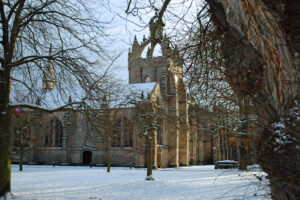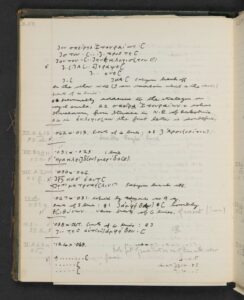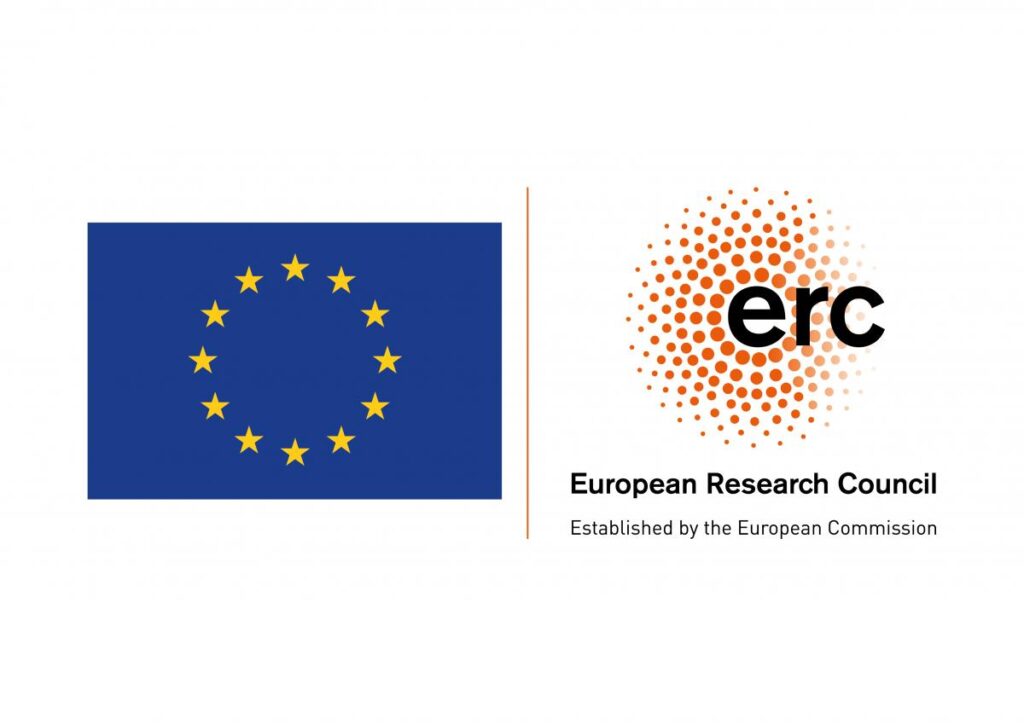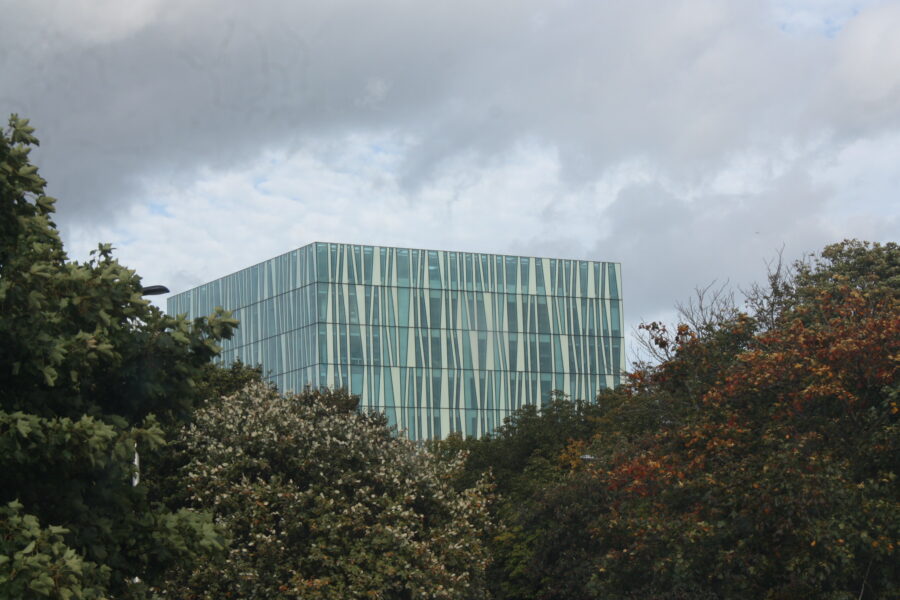The primary source material for the Caliphal Finances project consists of fiscal documents, excavated in Egypt and mostly written on papyrus and paper. Both Principal Investigator Marie Legendre and Postdoctoral Fellow Eline Scheerlinck have been studying previously unpublished fiscal documents in the collections where they are currently stored. The ERC grant enables us to travel to these collections to study the documents. On the blog, you can read about Eline’s research visits to the papyrus collection of the Austrian National Library in Vienna and to the Cambridge University Library. This time, we want to highlight a lesser-known collection which contains early Islamic papyri: the University Collections of the University of Aberdeen, right here in Scotland.

University of Aberdeen, King’s College. Photo by Tom Watt, licensed under CC BY-NC-SA 2.0.
The University Collections of the University of Aberdeen house approximately 4,900 fragments on papyrus, parchment, and paper, in Greek, Latin, Arabic, Coptic, Demotic, and Hieratic. About 30% of the collection is estimated to be written in languages other than Greek. The Greek papyri in this collection have received the most attention by far. In 1939, Eric Turner edited 197 Greek and Latin papyri and ostraca housed in Aberdeen in his Catalogue of Greek and Latin Papyri and Ostraca in the Possession of the University of Aberdeen (Aberdeen Univ. Studies 116), a volume now also known as P.Aberdeen. In recent years, other scholars have published Greek papyrus documents from the collection, including Greek fiscal lists and registers from the early Islamic period. The papyri are now kept at the Sir Duncan Rice Library of the University of Aberdeen (see banner image), while the ostraca are kept in the University Museums Collections at Marischal College.
The papyri of the University Collections were donated to the University of Aberdeen by the widow of James Andrew Sandilands Grant, a physician and University of Aberdeen alumnus, upon his death in 1896, along with other antiquities he had collected during his lifetime. Grant lived in Cairo during the 1880s and purchased the papyri on the antiquities market there around 1887. The bulk of the (Greek) papyri seem to have been excavated in the Fayyum, specifically from the village of Dimeh (Soknopaiou Nesos).
In the early 20th century, some papyri from the collection were published, but no attempt was made to catalogue and publish them on a large scale. This changed in 1918 when University of Aberdeen graduate John Gavin Tait received the Croom Robertson Fellowship to prepare a catalogue of the entire collection. One of his first actions in this role was to retrieve a large number of papyri that had been sent to Cambridge University Library for study and transcription a few years earlier.

University 621/9, Tait, John Gavin. Catalogue of papyri, p. 288. University of Aberdeen Special Collections.
Tait filled nine notebooks with his observations on the collection. These notebooks have recently been digitised by the University of Aberdeen and provide valuable insights into how the papyrus collection was managed in its early decades as part of the University Collections. After examining all the papyri, he organised them as follows:
I have decided to arrange the collection in the following order:
Latin papyri
Greek lit papyri
Greek non-literary papyri of the Roman period, those which are dated in chronological order, the others arranged according to subject
Greek papyri of the Byzantine period
Miscellaneous Greek fragments not worth copying
Hieroglyphic papyri
Hieratic papyri
Demotic papyri
Coptic papyri
Arabic papyri
Coptic and Arabic fragments on vellum and paper
Ostraca(University 621/1, Tait, John Gavin. Catalogue of papyri, p. 25.)
Tait made transcriptions and descriptions of the Latin and Greek papyri, which Turner acknowledged as very useful when preparing his 1939 editions. However, the multilingual nature of the collection made this a daunting task for Tait, and in his notebooks, he confessed his uncertainties:
As for the Egyptian and Arabic papyri, it is somewhat unfortunate that they have come to a place where there is no one who can read them. For my part, I must admit that I cannot always even distinguish with certainty between hieratic and demotic, or between demotic and Arabic.
(University 621/1, Tait, John Gavin. Catalogue of papyri, p. 23.)
David Samuel Margoliouth (1858–1940), who was Laudian Professor of Arabic (now Abdulaziz Saud AlBabtain Laudian Professor) at the University of Oxford at the time, studied the Arabic papyri in the collection and provided some partial translations, which Tait copied into his notebooks. Tait recorded a letter from Margoliouth in one of his notebooks:
The Arabic papyri in this collection have been examined by Rev. Prof. D. S. Margoliouth of Oxford, who says in a letter to Mr Anderson [presumably Peter John Anderson, University of Aberdeen librarian from 1894 to 1926], dated 10th January 1923:
“The scraps vary in date from the second to the fifth century of Islam, but appear to be mainly of the third. Those which are dated in the fifth century are on paper. … The great number of the scraps are bits of old letters, of which in many cases only the introductory formulae remain. The amount preserved in the other cases is rarely if ever sufficient to furnish any continuous sense. In many cases the recto and verso contain scraps of different documents, and in not a few the ink after use has been washed and received a piece of fresh writing. Specimens of private (?) documents belonging to those periods are by no means devoid of interest, and may well therefore find a place in a university library; but for the reasons given I fear the historical matter to be derived from this collection will be inconsiderable.”
(University 621/9, Tait, John Gavin. Catalogue of papyri, p. 171.)
Despite Margoliouth’s initial dismissiveness about the Arabic papyri in the collection, I have been able to identify at least one or two papyri of interest to the Caliphal Finances project, as they pertain to the fiscal administration of Abbasid Egypt.
Our next step will be to visit the collection in Aberdeen, so stay tuned for further updates!
I wish to thank our colleagues at the Special Collections of the University of Aberdeen who have been very helpful, especially Michelle Gait.
This post has been written by Eline Scheerlinck.




Leave a Reply